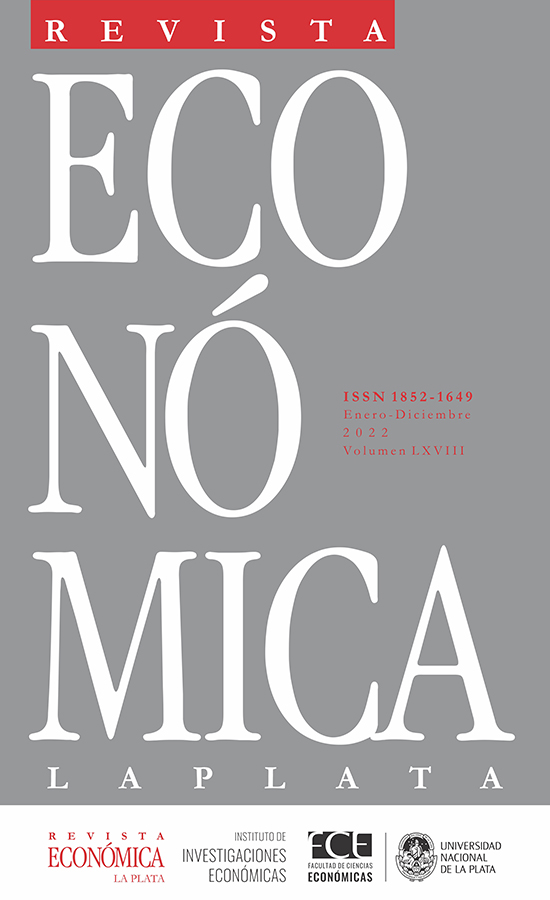Characterization of the vulnerable population: A proposal with estimates for Argentina
DOI:
https://doi.org/10.24215/18521649e028Keywords:
poverty, chronic poverty, vulnerability, ArgentinaAbstract
We propose to define the most vulnerable population of a country as those individuals in households with a high probability of being poor by income in the present, and under the different scenarios of the recent past. We argue that this definition allows a more accurate characterization of the deprived population than the traditional one based on current income. The methodology is illustrated with estimates for Argentina.
Downloads
Metrics
References
Alkire, S., Foster, J., Seth, S. Santos, M., Roche, J. y Ballon, P. (2015). Multidimensional poverty measurement and analysis. Oxford University Press.
Beccaria, L. y Gluzmann, P. (2013). Medición de los ingresos y la pobreza oficial en América Latina y el Caribe (Documento de trabajo No. 148). Centro de Estudios Distributivos, Laborales y Sociales (CEDLAS), Universidad Nacional de La Plata.
Bourguignon, F. (2003). From income to endowments: the difficult task of expanding the income poverty paradigm (Working paper 2003-03). Departement et Laboratoire de Economie Theorique et Appliquee (DELTA), Centre National de la Recherche Scientifique.
Chaudhuri, S. (2003). Assessing vulnerability to poverty: concepts, empirical methods and illustrative examples. Departamento de Economía, Universidad de Columbia.
Chaudhuri, S., Jalan, J. y Suryahadi, A. (2002). Assessing household vulnerability to poverty from cross-sectional data: a methodology and estimates from Indonesia (Documento de Trabajo 0102-52). Departmento de Economía, Universidad de Columbia.
Cruces, G., Lanjouw, P., Lucchetti, L., Perova, E., Vakis, R. y Viollaz, M. (2015). Intra-Generational Mobility and Repeated Cross-Sections: A Three- Country Validation Exercise. Journal of Economic Inequality, 13(2), 161-179.
Dang, H., Lanjouw, P., Luoto, J. y McKenzie, D. (2014). Using Repeated Cross- Sections to Explore Movements into and out of Poverty. Journal of Development Economics, 107, 112-128.
Dang, H. y Ianchovichina, E. (2018). Welfare Dynamics with Synthetic Panels: The Case of the Arab World in Transition. Review of Income and Wealth, 64, S114-S144.
Deaton, A. (1997). The analysis of household surveys: Microeconomic analysis for development policy. World Bank Publications.
Deaton, A. y Zaidi, S. (2002). Guidelines for Constructing Consumption Aggregates for Welfare Analysis (Working Paper No. 135). Living Standards Measurement Study (LSMS), World Bank.
Elbers, Lanjouw, J. y Lanjouw, P. (2003). Micro-level estimation of poverty and inequality. Econometrica, 71(1), 355-364.
Feres, J. y Mancero, X. (2001). Enfoques para la medición de la pobreza. Breve revisión de la literatura. Estudios estadísticos y prospectivos, 4, Comisión Económica para América Latina y el Caribe (CEPAL), Naciones Unidas.
Ferreira, F., Messina, J., Rigolini, J., López-Calva, L.F., Lugo, M.A. y Vakis, R. (2013). Economic Mobility and the Rise of the Latin American Middle Class. World Bank Publications.
Gallardo, M. (2018). Identifying vulnerability to poverty: a critical survey. Journal of Economic Surveys, 32(4), 1074-1105.
Gasparini, L., Cicowiez M. y Sosa Escudero, W. (2013). Pobreza y desigualdad en América Latina: conceptos, herramientas y aplicaciones. Temas Grupo Editorial.
Hentschel, H., Lanjouw, J., Lanjouw, P. y Poggi, J. (2000). Combining census and survey data to trace the spatial dimensions of poverty: a case study of Ecuador. The World Bank Economic Review, 14 (1), 147-165.
Hérault, N. y Jenkins, S. (2019). How valid are synthetic panel estimates of poverty dynamics? The Journal of Economic Inequality, 17(1), 51-76.
Hoddinott, J. y Quisumbing, A. (2003). Methods of microeconometric risk and vulnerability assessments (Social Protection Discussion Paper No. 0323). World Bank.
Kakwani, N. y Silber, J. (Eds.) (2007). The many dimensions of poverty. Palgrave Macmillan.
Klasen, S. y Waibel, H. (2013). Vulnerability to poverty: theory, measurement, and determinants, with case studies from Thailand and Vietnam. Palgrave Macmillan.
López-Calva, L. F. y Ortiz-Juarez, E. (2014). A Vulnerability Approach to the Definition of the Middle Class. Journal of Economic Inequality, 12(1), 23-47.
Ravallion, M. (2011). On multidimensional indices of poverty (Policy Research Working Paper No. 5580). World Bank.
Santos, M. E. y Villatoro, P. (2018). A multidimensional poverty index for Latin America. Review of Income and Wealth, 64(1), 52-82.
Sen, A. (1976). Poverty: An ordinal approach to measurement. Econometrica, 44(2), 291-231.
Sen, A. (1984). Resources, values, and development. Basil Blackwell.
Sen, A. (1992). Inequality reexamined. Oxford University Press.
Published
How to Cite
Issue
Section
License
Copyright (c) 2022 Leonardo Gasparini, Pablo Gluzmann, Leopoldo Tornarolli

This work is licensed under a Creative Commons Attribution-NonCommercial-NoDerivatives 4.0 International License.
The material published in the journal is distributed under a Creative Commons Attribution-NonCommercial-NoDerivatives 4.0 International (CC BY-NC-ND 4.0) license. This license requires proper credit to be given, a link to the license to be provided, and changes to be indicated. It does not permit commercial use of the work, and if the work is remixed, transformed, or otherwise modified, distribution of such modification is not allowed.






























